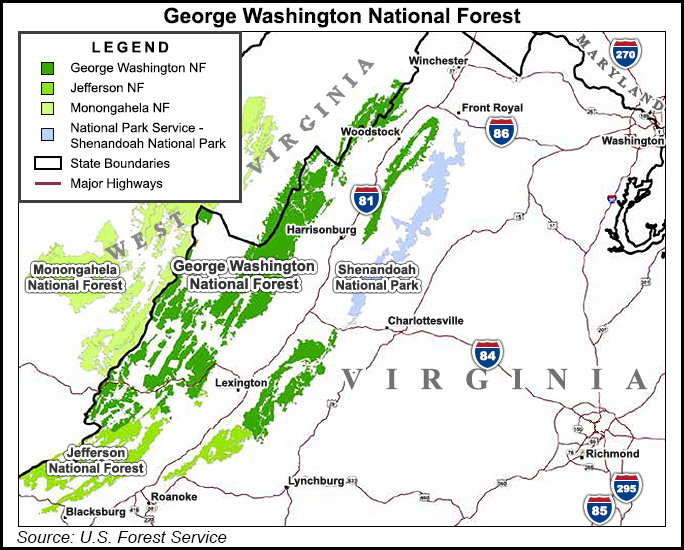Marcellus | E&P | NGI All News Access | NGI The Weekly Gas Market Report
Forest Service Plan to Allow Fracking in George Washington National Forest
A long-awaited plan for the management of the 1.1-million-acre George Washington National Forest (GWNF) in the Appalachian Mountains of Virginia and West Virginia, released Tuesday by the U.S. Forest Service’s (USFS) Southern Regional Forester, would allow oil and natural gas drilling on 177,200 GWNF acres and does not include proposed bans on horizontal drilling and hydraulic fracturing (fracking).

“The plan includes a decision that limits availability for new oil and gas leasing, while establishing a comprehensive framework for potential development on about 10,000 acres where there are existing valid leases, as well as on 167,200 acres with existing private mineral rights,” USFS said. “Presently, none of the existing federal leases or existing privately owned mineral rights on the forest are active. There is also no mineral development occurring on adjacent private lands.
“The decision does not prohibit any specific technology for developing oil and gas resources, including hydraulic fracturing. Any proposal to develop existing leases on the forest would undergo additional environmental analysis and provide opportunities for public comment and engagement.”
GWNF “has never been a supplier of natural gas and there has been no recent expression of interest in exploring or developing GWNF lands,” according to the agency.
The 374-page Revised Land and Resource Management Plan and Record of Decision revise the previous GWNF plan, which had been in place for more than 20 years. The new plan is expected to go into effect early next year.
A draft management plan that USFS had considered for the GWNF would have allowed gas leasing on nearly one million acres but prohibited horizontal drilling on all federal leases (see Shale Daily, Oct. 25, 2011; Daily GPI, May 23, 2011). The American Petroleum Institute (API) had urged USFS to reject proposals to ban horizontal drilling in the GWNF; environmental groups, the Council of the District of Columbia and others had supported such a ban (see Shale Daily, March 7).
On Tuesday, the Virginia Petroleum Council (VPC), a division of API, commended the USFS plan. “The success of domestic natural gas production depends on our ability to produce energy from shale through hydraulic fracturing, and the industry is committed to ensuring that it will continue to be employed in a safe and responsible manner,” said Michael Ward, VPC executive director.
The plan provides “a comprehensive, balanced strategy for energy development consistent with other resource values, including for wind and oil and gas,” according to USFS. The plan also assures water quality, improved wildlife habitat, healthy forests, local economic opportunities, and enhances and protects recreation opportunities within the GWNF, the agency said.
“Our work does not end with approval of this plan,” said Tom Speaks, forest supervisor of the George Washington and the connecting 700,000-acre Jefferson National Forests. “The next step is to work together to develop and implement projects that move us toward the vision described in the plan.”
The GWNF land mass, which overlies portions of the Marcellus Shale, runs north-south with most of the forest lying on the Virginia side of the Virginia-West Virginia border. The only area with active natural gas drilling is in the far southwest corner of Virginia in the Jefferson Forest. The production there is in more traditional deposits with no horizontal drilling. A management plan completed for the Jefferson Forest in 2004 includes no restrictions on horizontal drilling.
© 2024 Natural Gas Intelligence. All rights reserved.
ISSN © 2577-9877 | ISSN © 1532-1266 | ISSN © 2158-8023 |
